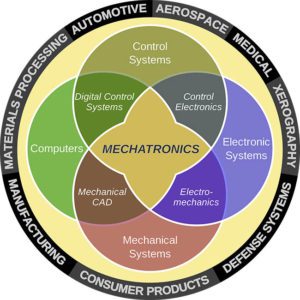RAMPing up online
Mechatronics goes digital, expands access to rural students
Offers new certificate in Mechatronics Fundamentals
By Rhonda Morin
 [dropcap]I[/dropcap]t all started with robots. Mechatronics professor Ken Luchini toyed with the idea of applying for a National Science Foundation (NSF) grant to build a robot with mechanical hands that can grip objects. Instructors would use it at recruiting fairs and events to entice students to enroll in Clark’s program. The robot would be able to pick up objects or weld straight-lined patterns on a stainless steel container.
[dropcap]I[/dropcap]t all started with robots. Mechatronics professor Ken Luchini toyed with the idea of applying for a National Science Foundation (NSF) grant to build a robot with mechanical hands that can grip objects. Instructors would use it at recruiting fairs and events to entice students to enroll in Clark’s program. The robot would be able to pick up objects or weld straight-lined patterns on a stainless steel container.
Yet when Luchini started researching NSF grants, he discovered the organization was more apt to fund instructor trainings. He met with department head and colleague Christopher Lewis to reshape the idea into a hybrid course—a series of online and face-to-face classes—so students from distant areas of the state wouldn’t have to drive to campus every day.
Reaching residents who live in rural and underserved areas from Clark’s service district, particularly in parts of Skamania and Klickitat counties, is a challenge. Clark has four locations—the main campus on Fort Vancouver Way, Clark College at Washington State University Vancouver, Economic & Community Development in downtown Vancouver and Columbia Tech Center on SE Mill Plain Boulevard. However, for residents living or working outside these areas, getting to class several times a week can be tough.
In an effort to solve the dilemma, Clark College submitted a grant application to NSF to build a hybrid course to reach these potential students. Last summer, Clark passed the first hurdle and was awarded $200,000 from NSF’s Advanced Technological Education (ATE) program—the first ever NSF grant for the college. ATE supports curriculum and professional development and partnerships between academic institutions and industry.
Now work is underway to train the teachers, write the curriculum for a brand-new certificate and recruit students.
Economic impact
Mechatronics is a blend of mechanics and electronics managed by computer, electrical or mechanical systems. It’s what powers and controls machinery and technology in manufacturing industries. The American Society of Mechanical Engineers describes mechatronics as the sweet spot where mechanical, electronic, control and software engineering come together.
Clark College’s Mechatronics program stands apart from other programs at colleges and universities in Washington.
“We provide mechanical, instrumentation and business concepts in our coursework,” said Lewis, adding, “There are other colleges that offer other aspects of the field like micro-electronics or instrumentation, but Clark is the only one that offers coursework that addresses these areas in mechatronics—from fundamental mechanical concepts to supervisory controls and data collection techniques utilizing instrumentation components coupled with soft skills integration needed to be successful in manufacturing today.”
“You’d have to go to Southern California to find the type of program that Clark has,” he said.
There are skilled jobs in mechatronics and advanced manufacturing to be filled in the region and a propensity for residents to work and live in the same county. Employment in fields such as electronics, metal fabrication, semiconductor and electronics components and aerospace is projected to increase by 14 percent in Clark’s service district area by 2024, according to a 2015 economic overview and workforce gap study conducted by the labor market analytics firm, Economic Modeling Specialists International (EMSI).
Keeping educated people working in Southwest Washington and the Portland Metro area has distinct advantages for regional economies. Oregon is one of the top four states in the nation that benefits from durable goods manufacturing. This is reflected in its state Gross Domestic Product (GDP) and the number of greater Portland residents employed in manufacturing—177,000, according to a 2015 report by Beth Fitz Gibbon, “Creating a Sound Economy through Advanced Manufacturing with Advanced Materials, Robust Supply Chains.”
The industrial machinery and equipment industry leads the way in Washington in terms of the number of employees. In Oregon, electronics and electric equipment tops the list. Leading regional manufacturing companies include WaferTech in Camas, Wash., SEH America in Vancouver, Wash., Intel Corporation in Hillsboro, Ore., and Daimler Trucks North America LLC in Portland, Ore., according to Fitz Gibbon.
Forty-nine percent of Clark County residents work in Clark County, while a quarter commute to jobs in the Portland Metro area. A smaller number of people—11 percent—commute to either King County in Washington or into Oregon’s Washington County, according to the EMSI report.
Advanced manufacturing industries in Southwest Washington and the Portland Metro area hire mechatronics technicians. The jobs require trouble-shooting and problem-solving skills, the ability to operate complex precision equipment and soft skills such as how to communicate with supervisors and co-workers on the job, the ability to work in teams, and how to write reports and communicate the results.
Clark has been training future workers in the mechatronics field for entry-level jobs with these skills for the past five years and now is in a position to expand the training in order to bring the classroom to residents living in rural areas.
One way to enter the mechatronics field is through Clark’s new 21-hour certificate program. Students who complete the certificate in Mechatronics Fundamentals are prepared for entry-level technician jobs such as operator, technical helper or technical apprentice. Once they complete the work, they have the option of working toward other certificates, an associate degree and a bachelor’s.
Students enrolled in Clark’s current Mechatronics program learn about automation, conveyors and robotics in traditional classroom settings with face-to-face lectures and hands-on laboratory work. In hybrid form, what is the practicality of troubleshooting a mechanical problem online? That is precisely the challenge that faculty members are preparing to solve.
First hybrid
This will be the first hybrid Mechatronics course since Lewis created the program in 2011. Online course development is not simple. There are a series of preparation classes instructors can take from mastering Clark’s electronic learning management system—called Canvas—to choosing the videos that fulfill learning objectives. The process can take 80 to 100 hours per course to build before the class even starts.
Clark also has a peer-review process in place to ensure that online and hybrid courses—also known as blended courses—meet high standards.
“These are not a work-at-your-own-pace on your-own-time courses,” said Kathy Chatfield, senior eLearning instructional designer. The courses have a specific progression that students must follow throughout the quarter.
The same is true for faculty and instructor eLearning training.
“In those courses, we teach faculty how to engage their students, encourage demonstrating how students can work in teams, and we offer skills for clear and consistent communication between instructors and students,” said Chatfield.
Though preparing for hybrid courses is a lot of up-front work, Clark has the staff support to assist faculty and instructors, said Chatfield. Through the eLearning department, there are workshops in which a course can be designed from start to finish. Resources range from getting familiar with Clark’s multimedia production studio, to how to use instructional videos, audio files and streaming services, to setting up grading for courses using Canvas.
“Many faculty members return later to report on the ways that learning about online and hybrid course development has positively influenced their web-enhanced or face-to-face courses,” said Chatfield.
There will be eight courses, consisting of 21 credits, required to complete the new certificate in Mechatronics Fundamentals. Several of the courses will be online, such as safety and direct current (DC) and alternating current (AC) fundamentals. But a portion must be completed in a laboratory, either at the Columbia Tech Center or another venue that has yet to be established.
“The movement to online learning hasn’t been as attractive to us in the past because of the hands-on nature of mechatronics,” said Genevieve Howard, dean of Clark’s Workforce, Career and Technical Education unit.
The NSF funding, coupled with the willingness of faculty members to build a new curriculum, inspired a flurry of new ideas. The details must be ironed out over the next year, such as how many face-to-face laboratory hours students will need. However, Howard expects those hours to be far fewer per quarter than traditional laboratory courses.
Community partners—businesses, community centers, other schools—could house temporary classes in Skamania and Klickitat counties. Down the road, Lewis envisions a self-contained mobile unit filled with instruments and mechanical devices that can be delivered to the students, offering even greater access to higher education.
Columbia Machine ScholarshipColumbia Machine has established a scholarship in support of Clark’s Mechatronics, Machining and Welding students. The Vancouver-based industrial equipment manufacturer is excited to offer opportunities for students to enter the global equipment manufacturing business. Rick Goode, Columbia CEO, said, “”Clark has worked closely with Columbia for many years to educate the technical talent we need in order to grow our business and compete globally. The scholarships support the programs that are important to our success.” Columbia Machine does business in over 100 countries. |
The preparation
The NSF grant gives Clark three years to prepare, recruit 16 rural students, start the classes and reflect on the process. Lewis expects to have the first course open by September 2017. By the third year, he’s committed to seeing more than 16 individuals complete the certificate and having six faculty members proficient in eLearning. The effect on the rural areas of the state will be positive, according to Lewis.
“We are preparing people in our rural communities for entry-level technical jobs—something industry in our state is insisting we do,” said Lewis.
Preparing entry-level employees is one pathway for a better job, but Clark continues to focus on beefing up the number of highly skilled mechatronics technicians. Once students complete the new certificate, they will be on track to begin an associate in Applied Technology (AAT) degree, and could take it one step further with a bachelor’s in Applied Science in Applied Management (ASAM). The bachelor’s degree is also new—it will launch in January 2017—and is directed at individuals looking to pursue management jobs or operate their own business.
“The new hybrid certificate strengthens our program, because it gives students another entry point into mechatronics,” said Lewis, adding “it also offers them a stepping stone to a degree and a better job at a higher wage and offers advancement within a company. It’s tapping into a pipeline of potential employees—it’s expanding the net of potential employees.”
We are giving more people an opportunity for education and better paying jobs. These folks don’t want to leave their homes, they want to live and work in the communities they love. This hybrid program addresses that need.
As students go through the program, they advance through a variety of levels of proficiency, accumulating skills that prepare them for jobs such as assistant control systems technician, electronics repair technician, automation technical helper, wind-energy engineer or robotics technician.
Tech’s future
This is a test for Clark’s Workforce, Career and Technical Education unit. Should the switch to a blend of online and hands-on laboratory coursework go well, then opportunities may open to augment other curricula within the Workforce, Career and Technical Education unit.
“Our hope is that we can replicate this hybrid model in other areas of career and technical education, potentially with further NSF assistance,” said Howard.
There’s a budding future for hybrid courses across all of Clark’s professional and technical stratosphere. “We want to be able to do this with Automotive, Machining and Welding Technology programs,” said Lewis.
12/15/2016




